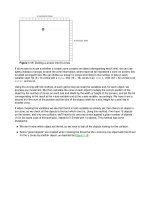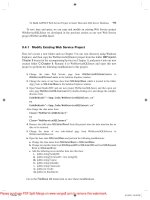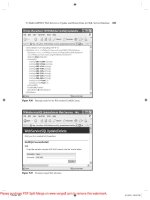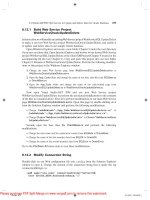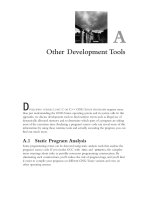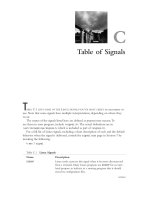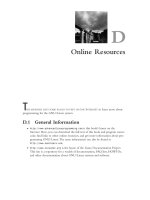Tài liệu Advanced Linux Programming: 1-Advanced UNIX Programming with Linux pdf
Bạn đang xem bản rút gọn của tài liệu. Xem và tải ngay bản đầy đủ của tài liệu tại đây (230.31 KB, 16 trang )
Advanced UNIX Programming
with Linux
I
1 Getting Started
2 Writing Good GNU/Linux Software
3 Processes
4 Threads
5 Interprocess Communication
01 0430 PT01 5/22/01 10:09 AM Page 1
01 0430 PT01 5/22/01 10:09 AM Page 2
Getting Started
1
THIS CHAPTER SHOWS YOU HOW TO PERFORM THE BASIC steps required to create a
C or C++ Linux program. In particular, this chapter shows you how to create and
modify C and C++ source code, compile that code, and debug the result. If you’re
already accustomed to programming under Linux, you can skip ahead to Chapter 2,
“Writing Good GNU/Linux Software;” pay careful attention to Section 2.3, “Writing
and Using Libraries,” for information about static versus dynamic linking that you
might not already know.
Throughout this book, we’ll assume that you’re familiar with the C or C++ pro-
gramming languages and the most common functions in the standard C library.The
source code examples in this book are in C, except when demonstrating a particular
feature or complication of C++ programming.We also assume that you know how to
perform basic operations in the Linux command shell, such as creating directories and
copying files. Because many Linux programmers got started programming in the
Windows environment, we’ll occasionally point out similarities and contrasts between
Windows and Linux.
02 0430 CH01 5/22/01 10:19 AM Page 3
4
Chapter 1 Getting Started
1.1 Editing with Emacs
An editor is the program that you use to edit source code. Lots of different editors are
available for Linux, but the most popular and full-featured editor is probably GNU
Emacs.
About Emacs
Emacs is much more than an editor. It is an incredibly powerful program, so much so that at
CodeSourcery, it is affectionately known as the One True Program, or just the OTP for short. You can read
and send email from within Emacs, and you can customize and extend Emacs in ways far too numerous
to discuss here. You can even browse the Web from within Emacs!
If you’re familiar with another editor, you can certainly use it instead. Nothing in the
rest of this book depends on using Emacs. If you don’t already have a favorite Linux
editor, then you should follow along with the mini-tutorial given here.
If you like Emacs and want to learn about its advanced features, you might consider
reading one of the many Emacs books available. One excellent tutorial, Learning
GNU Emacs, is written by Debra Cameron, Bill Rosenblatt, and Eric S. Raymond
(O’Reilly, 1996).
1.1.1 Opening a C or C++ Source File
You can start Emacs by typing emacs in your terminal window and pressing the
Return key.When Emacs has been started, you can use the menus at the top to create
a new source file. Click the Files menu, choose Open Files, and then type the name of
the file that you want to open in the “minibuffer” at the bottom of the screen.
1
If you
want to create a C source file, use a filename that ends in .c or .h. If you want to
create a C++ source file, use a filename that ends in .cpp, .hpp, .cxx, .hxx, .C, or .H.
When the file is open, you can type as you would in any ordinary word-processing
program.To save the file, choose the Save Buffer entry on the Files menu.When
you’re finished using Emacs, you can choose the Exit Emacs option on the Files
menu.
If you don’t like to point and click, you can use keyboard shortcuts to automatically
open files, save files, and exit Emacs.To open a file, type C-x C-f. (The C-x means to
hold down the Control key and then press the x key.) To save a file, type C-x C-s.To
exit Emacs, just type C-x C-c. If you want to get a little better acquainted with Emacs,
choose the Emacs Tutorial entry on the Help menu.The tutorial provides you with
lots of tips on how to use Emacs effectively.
1. If you’re not running in an X Window system, you’ll have to press F10 to access the
menus.
02 0430 CH01 5/22/01 10:19 AM Page 4
5
1.1 Editing with Emacs
1.1.2 Automatic Formatting
If you’re accustomed to programming in an Integrated Development Environment (IDE),
you’ll also be accustomed to having the editor help you format your code. Emacs can
provide the same kind of functionality. If you open a C or C++ source file, Emacs
automatically figures out that the file contains source code, not just ordinary text. If
you hit the Tab key on a blank line, Emacs moves the cursor to an appropriately
indented point. If you hit the Tab key on a line that already contains some text, Emacs
indents the text. So, for example, suppose that you have typed in the following:
int main ()
{
printf (“Hello, world\n”);
}
If you press the Tab key on the line with the call to printf, Emacs will reformat your
code to look like this:
int main ()
{
printf (“Hello, world\n”);
}
Notice how the line has been appropriately indented.
As you use Emacs more, you’ll see how it can help you perform all kinds of
complicated formatting tasks. If you’re ambitious, you can program Emacs to perform
literally any kind of automatic formatting you can imagine. People have used this
facility to implement Emacs modes for editing just about every kind of document,
to implement games
2
, and to implement database front ends.
1.1.3 Syntax Highlighting
In addition to formatting your code, Emacs can make it easier to read C and C++
code by coloring different syntax elements. For example, Emacs can turn keywords
one color, built-in types such as int another color, and comments another color.
Using color makes it a lot easier to spot some common syntax errors.
The easiest way to turn on colorization is to edit the file ~/.emacs and insert the
following string:
(global-font-lock-mode t)
Save the file, exit Emacs, and restart. Now open a C or C++ source file and enjoy!
You might have noticed that the string you inserted into your .emacs looks like
code from the LISP programming language.That’s because it is LISP code! Much of
Emacs is actually written in LISP.You can add functionality to Emacs by writing more
LISP code.
2.Try running the command M-x dunnet if you want to play an old-fashioned text
adventure game.
02 0430 CH01 5/22/01 10:19 AM Page 5
6
Chapter 1 Getting Started
1.2 Compiling with GCC
A compiler turns human-readable source code into machine-readable object code that
can actually run.The compilers of choice on Linux systems are all part of the GNU
Compiler Collection, usually known as GCC.
3
GCC also include compilers for C,
C++, Java, Objective-C, Fortran, and Chill.This book focuses mostly on C and C++
programming.
Suppose that you have a project like the one in Listing 1.2 with one C++ source
file (reciprocal.cpp) and one C source file (main.c) like in Listing 1.1.These two files
are supposed to be compiled and then linked together to produce a program called
reciprocal.
4
This program will compute the reciprocal of an integer.
Listing 1.1 (main.c) C source file—main.c
#include <stdio.h>
#include “reciprocal.hpp”
int main (int argc, char **argv)
{
int i;
i = atoi (argv[1]);
printf (“The reciprocal of %d is %g\n”, i, reciprocal (i));
return 0;
}
Listing 1.2 (reciprocal.cpp) C++ source file—reciprocal.cpp
#include <cassert>
#include “reciprocal.hpp”
double reciprocal (int i) {
// I should be non-zero.
assert (i != 0);
return 1.0/i;
}
3. For more information about GCC, visit .
4. In Windows, executables usually have names that end in
.exe. Linux programs, on the
other hand, usually have no extension. So, the Windows equivalent of this program would
probably be called
reciprocal.exe; the Linux version is just plain reciprocal.
02 0430 CH01 5/22/01 10:19 AM Page 6
7
1.2 Compiling with GCC
There’s also one header file called reciprocal.hpp (see Listing 1.3).
Listing 1.3 (reciprocal.hpp) Header file—reciprocal.hpp
#ifdef __cplusplus
extern “C” {
#endif
extern double reciprocal (int i);
#ifdef __cplusplus
}
#endif
The first step is to turn the C and C++ source code into object code.
1.2.1 Compiling a Single Source File
The name of the C compiler is gcc. To compile a C source file, you use the -c
option. So, for example, entering this at the command prompt compiles the main.c
source file:
% gcc -c main.c
The resulting object file is named main.o.
The C++ compiler is called g++. Its operation is very similar to gcc; compiling
reciprocal.cpp is accomplished by entering the following:
% g++ -c reciprocal.cpp
The -c option tells g++ to compile the program to an object file only; without it, g++
will attempt to link the program to produce an executable. After you’ve typed this
command, you’ll have an object file called reciprocal.o.
Yo u ’ll probably need a couple other options to build any reasonably large program.
The
-I option is used to tell GCC where to search for header files. By default, GCC
looks in the current directory and in the directories where headers for the standard
libraries are installed. If you need to include header files from somewhere else, you’ll
need the -I option. For example, suppose that your project has one directory called
src, for source files, and another called include.You would compile reciprocal.cpp
like this to indicate that g++ should use the /include directory in addition to find
reciprocal.hpp:
% g++ -c -I /include reciprocal.cpp
02 0430 CH01 5/22/01 10:19 AM Page 7
8
Chapter 1 Getting Started
Sometimes you’ll want to define macros on the command line. For example, in
production code, you don’t want the overhead of the assertion check present in
reciprocal.cpp; that’s only there to help you debug the program.You turn off
the check by defining the macro NDEBUG. You could add an explicit #define to
reciprocal.cpp, but that would require changing the source itself. It’s easier to
simply define NDEBUG on the command line, like this:
% g++ -c -D NDEBUG reciprocal.cpp
If you had wanted to define NDEBUG to some particular value, you could have done
something like this:
% g++ -c -D NDEBUG=3 reciprocal.cpp
If you’re really building production code, you probably want to have GCC optimize
the code so that it runs as quickly as possible.You can do this by using the -O2
command-line option. (GCC has several different levels of optimization; the second
level is appropriate for most programs.) For example, the following compiles
reciprocal.cpp with optimization turned on:
% g++ -c -O2 reciprocal.cpp
Note that compiling with optimization can make your program more difficult to
debug with a debugger (see Section 1.4, “Debugging with GDB”).Also, in certain
instances, compiling with optimization can uncover bugs in your program that did not
manifest themselves previously.
You can pass lots of other options to gcc and g++.The best way to get a complete
list is to view the online documentation.You can do this by typing the following at
your command prompt:
% info gcc
1.2.2 Linking Object Files
Now that you’ve compiled main.c and utilities.cpp,you’ll want to link them.You
should always use
g++ to link a program that contains C++ code, even if it also con-
tains C code. If your program contains only C code, you should use gcc instead.
Because this program contains both C and C++, you should use g++, like this:
% g++ -o reciprocal main.o reciprocal.o
The -o option gives the name of the file to generate as output from the link step.
Now you can run reciprocal like this:
% ./reciprocal 7
The reciprocal of 7 is 0.142857
As you can see, g++ has automatically linked in the standard C runtime library con-
taining the implementation of printf. If you had needed to link in another library
(such as a graphical user interface toolkit), you would have specified the library with
02 0430 CH01 5/22/01 10:19 AM Page 8
9
1.3 Automating the Process with GNU Make
the -l option. In Linux, library names almost always start with lib. For example,
the Pluggable Authentication Module (PAM) library is called libpam.a.To link in
libpam.a, you use a command like this:
% g++ -o reciprocal main.o reciprocal.o -lpam
The compiler automatically adds the lib prefix and the .a suffix.
As with header files, the linker looks for libraries in some standard places, including
the /lib and /usr/lib directories that contain the standard system libraries. If you
want the linker to search other directories as well, you should use the -L option,
which is the parallel of the -I option discussed earlier. You can use this line to instruct
the linker to look for libraries in the /usr/local/lib/pam directory before looking in
the usual places:
% g++ -o reciprocal main.o reciprocal.o -L/usr/local/lib/pam -lpam
Although you don’t have to use the -I option to get the preprocessor to search the
current directory, you do have to use the -L option to get the linker to search the
current directory. In particular, you could use the following to instruct the linker to
find the test library in the current directory:
% gcc -o app app.o -L. -ltest
1.3 Automating the Process with GNU Make
If you’re accustomed to programming for the Windows operating system, you’re prob-
ably accustomed to working with an Integrated Development Environment (IDE).You
add sources files to your project, and then the IDE builds your project automatically.
Although IDEs are available for Linux, this book doesn’t discuss them. Instead, this
book shows you how to use GNU Make to automatically recompile your code, which
is what most Linux programmers actually do.
The basic idea behind make is simple.You tell make what targets you want to build
and then give rules explaining how to build them.You also specify dependencies that
indicate when a particular target should be rebuilt.
In our sample
reciprocal project, there are three obvious targets: reciprocal.o,
main.o, and the reciprocal itself. You already have rules in mind for building these
targets in the form of the command lines given previously.The dependencies require a
little bit of thought. Clearly, reciprocal depends on reciprocal.o and main.o because
you can’t link the complete program until you have built each of the object files.The
object files should be rebuilt whenever the corresponding source files change.There’s
one more twist in that a change to reciprocal.hpp also should cause both of the
object files to be rebuilt because both source files include that header file.
In addition to the obvious targets, there should always be a clean target.This target
removes all the generated object files and programs so that you can start fresh.The rule
for this target uses the rm command to remove the files.
02 0430 CH01 5/22/01 10:19 AM Page 9
10
Chapter 1 Getting Started
You can convey all that information to make by putting the information in a file
named Makefile. Here’s what Makefile contains:
reciprocal: main.o reciprocal.o
g++ $(CFLAGS) -o reciprocal main.o reciprocal.o
main.o: main.c reciprocal.hpp
gcc $(CFLAGS) -c main.c
reciprocal.o: reciprocal.cpp reciprocal.hpp
g++ $(CFLAGS) -c reciprocal.cpp
clean:
rm -f *.o reciprocal
You can see that targets are listed on the left, followed by a colon and then any depen-
dencies.The rule to build that target is on the next line. (Ignore the $(CFLAGS) bit
for the moment.) The line with the rule on it must start with a Tab character, or make
will get confused. If you edit your Makefile in Emacs, Emacs will help you with the
formatting.
If you remove the object files that you’ve already built, and just type
% make
on the command-line, you’ll see the following:
% make
gcc -c main.c
g++ -c reciprocal.cpp
g++ -o reciprocal main.o reciprocal.o
You can see that make has automatically built the object files and then linked them.
If you now change main.c in some trivial way and type make again, you’ll see the
following:
% make
gcc -c main.c
g++ -o reciprocal main.o reciprocal.o
You can see that make knew to rebuild main.o and to re-link the program, but it
didn’t bother to recompile reciprocal.cpp because none of the dependencies for
reciprocal.o had changed.
The $(CFLAGS) is a make variable.You can define this variable either in the
Makefile itself or on the command line. GNU make will substitute the value of the
variable when it executes the rule. So, for example, to recompile with optimization
enabled, you would do this:
% make clean
rm -f *.o reciprocal
% make CFLAGS=-O2
gcc -O2 -c main.c
g++ -O2 -c reciprocal.cpp
g++ -O2 -o reciprocal main.o reciprocal.o
02 0430 CH01 5/22/01 10:19 AM Page 10
11
1.4 Debugging with GNU Debugger (GDB)
Note that the -O2 flag was inserted in place of $(CFLAGS) in the rules.
In this section, you’ve seen only the most basic capabilities of make.You can find
out more by typing this:
% info make
In that manual, you’ll find information about how to make maintaining a Makefile
easier, how to reduce the number of rules that you need to write, and how to auto-
matically compute dependencies.You can also find more information in GNU,
Autoconf, Automake, and Libtool by Gary V.Vaughan, Ben Elliston,Tom Tromey, and
Ian Lance Taylor (New Riders Publishing, 2000).
1.4 Debugging with GNU Debugger (GDB)
The debugger is the program that you use to figure out why your program isn’t behav-
ing the way you think it should.You’ll be doing this a lot.
5
The GNU Debugger
(GDB) is the debugger used by most Linux programmers.You can use GDB to step
through your code, set breakpoints, and examine the value of local variables.
1.4.1 Compiling with Debugging Information
To use GDB, you’ll have to compile with debugging information enabled. Do this by
adding the -g switch on the compilation command line. If you’re using a Makefile as
described previously, you can just set CFLAGS equal to -g when you run make, as shown
here:
% make CFLAGS=-g
gcc -g -c main.c
g++ -g -c reciprocal.cpp
g++ -g -o reciprocal main.o reciprocal.o
When you compile with -g, the compiler includes extra information in the object files
and executables.The debugger uses this information to figure out which addresses cor-
respond to which lines in which source files, how to print out local variables, and so
forth.
1.4.2 Running GDB
You can start up gdb by typing:
% gdb reciprocal
When gdb starts up, you should see the GDB prompt:
(gdb)
5. …unless your programs always work the first time.
02 0430 CH01 5/22/01 10:19 AM Page 11
12
Chapter 1 Getting Started
The first step is to run your program inside the debugger. Just enter the command run
and any program arguments.Try running the program without any arguments, like
this:
(gdb) run
Starting program: reciprocal
Program received signal SIGSEGV, Segmentation fault.
__strtol_internal (nptr=0x0, endptr=0x0, base=10, group=0)
at strtol.c:287
287 strtol.c: No such file or directory.
(gdb)
The problem is that there is no error-checking code in main.The program expects
one argument, but in this case the program was run with no arguments.The SIGSEGV
message indicates a program crash. GDB knows that the actual crash happened in a
function called __strtol_internal.That function is in the standard library, and the
source isn’t installed, which explains the “No such file or directory” message.You can
see the stack by using the where command:
(gdb) where
#0 __strtol_internal (nptr=0x0, endptr=0x0, base=10, group=0)
at strtol.c:287
#1 0x40096fb6 in atoi (nptr=0x0) at /stdlib/stdlib.h:251
#2 0x804863e in main (argc=1, argv=0xbffff5e4) at main.c:8
You can see from this display that main called the atoi function with a NULL pointer,
which is the source of the trouble.
You can go up two levels in the stack until you reach main by using the up
command:
(gdb) up 2
#2 0x804863e in main (argc=1, argv=0xbffff5e4) at main.c:8
8 i = atoi (argv[1]);
Note that gdb is capable of finding the source for main.c, and it shows the line where
the erroneous function call occurred.You can view the value of variables using the
print command:
(gdb) print argv[1]
$2 = 0x0
That confirms that the problem is indeed a NULL pointer passed into atoi.
You can set a breakpoint by using the break command:
(gdb) break main
Breakpoint 1 at 0x804862e: file main.c, line 8.
02 0430 CH01 5/22/01 10:19 AM Page 12
13
1.5 Finding More Information
This command sets a breakpoint on the first line of main.
6
Now try rerunning the
program with an argument, like this:
(gdb) run 7
Starting program: reciprocal 7
Breakpoint 1, main (argc=2, argv=0xbffff5e4) at main.c:8
8 i = atoi (argv[1]);
You can see that the debugger has stopped at the breakpoint.
You can step over the call to atoi using the next command:
(gdb) next
9 printf (“The reciprocal of %d is %g\n”, i, reciprocal (i));
If you want to see what’s going on inside reciprocal, use the step command like this:
(gdb) step
reciprocal (i=7) at reciprocal.cpp:6
6 assert (i != 0);
Yo u ’re now in the body of the reciprocal function.
You might find it more convenient to run gdb from within Emacs rather than using
gdb directly from the command line. Use the command M-x gdb to start up gdb in an
Emacs window. If you are stopped at a breakpoint, Emacs automatically pulls up the
appropriate source file. It’s easier to figure out what’s going on when you’re looking at
the whole file rather than just one line of text.
1.5 Finding More Information
Nearly every Linux distribution comes with a great deal of useful documentation.You
could learn most of what we’ll talk about in this book by reading documentation in
your Linux distribution (although it would probably take you much longer).The doc-
umentation isn’t always well-organized, though, so the tricky part is finding what you
need. Documentation is also sometimes out-of-date, so take everything that you read
with a grain of salt. If the system doesn’t behave the way a man page (manual pages)
says it should, for instance, it may be that the man page is outdated.
To help you navigate, here are the most useful sources of information about
advanced Linux programming.
6. Some people have commented that saying break main is a little bit funny because
usually you want to do this only when
main is already broken.
02 0430 CH01 5/22/01 10:19 AM Page 13
14
Chapter 1 Getting Started
1.5.1 Man Pages
Linux distributions include man pages for most standard commands, system calls, and
standard library functions.The man pages are divided into numbered sections; for pro-
grammers, the most important are these:
(1) User commands
(2) System calls
(3) Standard library functions
(8) System/administrative commands
The numbers denote man page sections. Linux’s man pages come installed on your
system; use the man command to access them.To look up a man page, simply invoke
man name, where name is a command or function name. In a few cases, the same name
occurs in more than one section; you can specify the section explicitly by placing the
section number before the name. For example, if you type the following, you’ll get the
man page for the
sleep command (in section 1 of the Linux man pages):
% man sleep
To see the man page for the sleep library function, use this command:
% man 3 sleep
Each man page includes a one-line summary of the command or function.The
whatis name command displays all man pages (in all sections) for a command or
function matching name. If you’re not sure which command or function you want,
you can perform a keyword search on the summary lines, using man -k keyword.
Man pages include a lot of very useful information and should be the first place
you turn for help.The man page for a command describes command-line options and
arguments, input and output, error codes, configuration, and the like.The man page
for a system call or library function describes parameters and return values, lists error
codes and side effects, and specifies which include file to use if you call the function.
1.5.2 Info
The Info documentation system contains more detailed documentation for many core
components of the GNU/Linux system, plus several other programs. Info pages are
hypertext documents, similar to Web pages.To launch the text-based Info browser, just
type info in a shell window.You’ll be presented with a menu of Info documents
installed on your system. (Press Control+H to display the keys for navigating an Info
document.)
Among the most useful Info documents are these:
n
gcc—The gcc compiler
n
libc—The GNU C library, including many system calls
n
gdb—The GNU debugger
02 0430 CH01 5/22/01 10:19 AM Page 14
15
1.5 Finding More Information
n
emacs—The Emacs text editor
n
info—The Info system itself
Almost all the standard Linux programming tools (including ld, the linker; as, the
assembler; and gprof, the profiler) come with useful Info pages.You can jump directly
to a particular Info document by specifying the page name on the command line:
% info libc
If you do most of your programming in Emacs, you can access the built-in Info
browser by typing M-x info or C-h i.
1.5.3 Header Files
You can learn a lot about the system functions that are available and how to use
them by looking at the system header files.These reside in /usr/include and
/usr/include/sys. If you are getting compile errors from using a system call, for
instance, take a look in the corresponding header file to verify that the function’s
signature is the same as what’s listed in the man page.
On Linux systems, a lot of the nitty-gritty details of how the system calls work are
reflected in header files in the directories /usr/include/bits, /usr/include/asm, and
/usr/include/linux. For instance, the numerical values of signals (described in Section
3.3,“Signals,” in Chapter 3,“Processes”) are defined in /usr/include/bits/signum.h.
These header files make good reading for inquiring minds. Don’t include them
directly in your programs, though; always use the header files in /usr/include or as
mentioned in the man page for the function you’re using.
1.5.4 Source Code
This is Open Source, right? The final arbiter of how the system works is the system
source code itself, and luckily for Linux programmers, that source code is freely avail-
able. Chances are, your Linux distribution includes full source code for the entire sys-
tem and all programs included with it; if not, you’re entitled under the terms of the
GNU General Public License to request it from the distributor. (The source code
might not be installed on your disk, though. See your distribution’s documentation for
instructions on installing it.)
The source code for the Linux kernel itself is usually stored under
/usr/src/linux.
If this book leaves you thirsting for details of how processes, shared memory, and sys-
tem devices work, you can always learn straight from the source code. Most of the
system functions described in this book are implemented in the GNU C library;
check your distribution’s documentation for the location of the C library source code.
02 0430 CH01 5/22/01 10:19 AM Page 15
02 0430 CH01 5/22/01 10:19 AM Page 16
